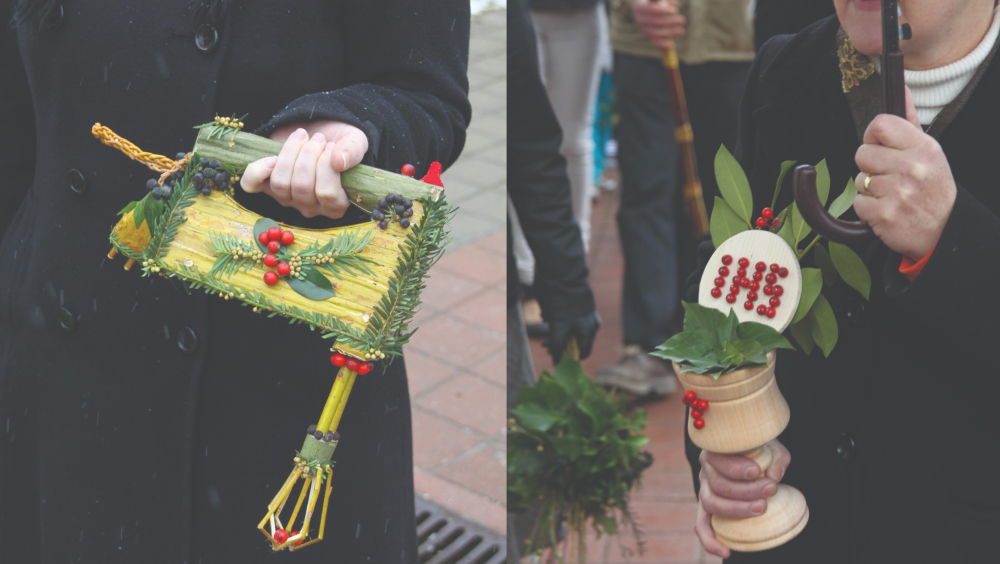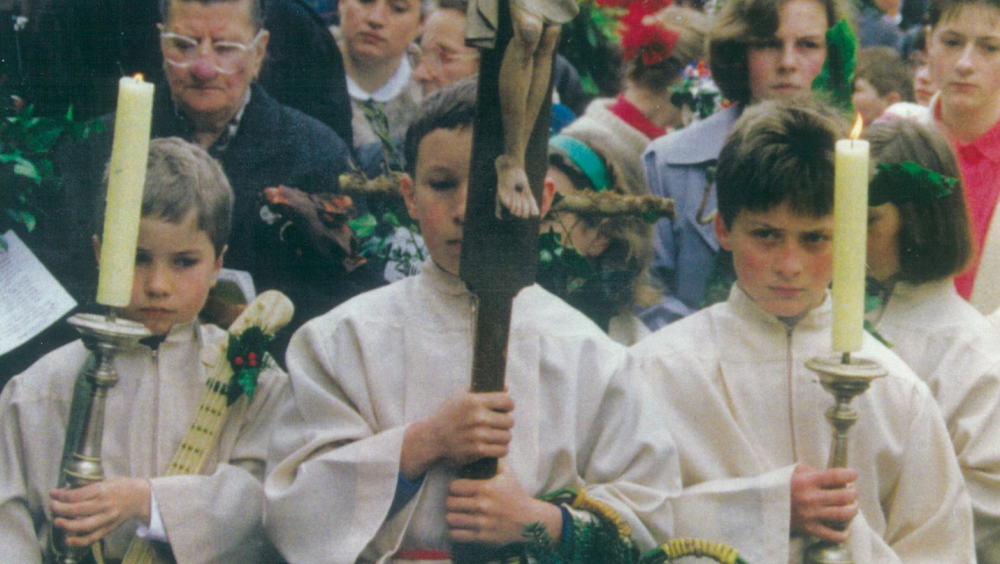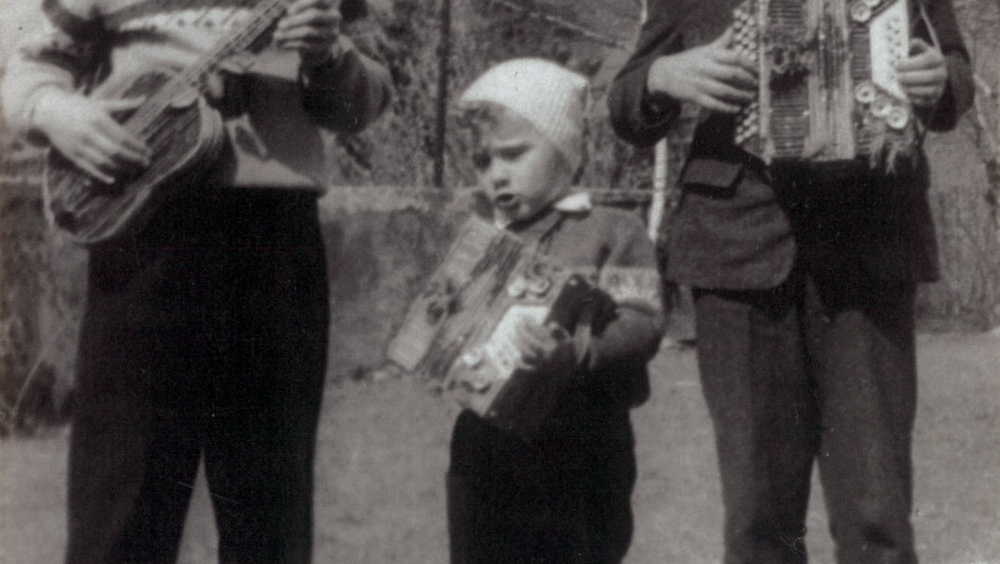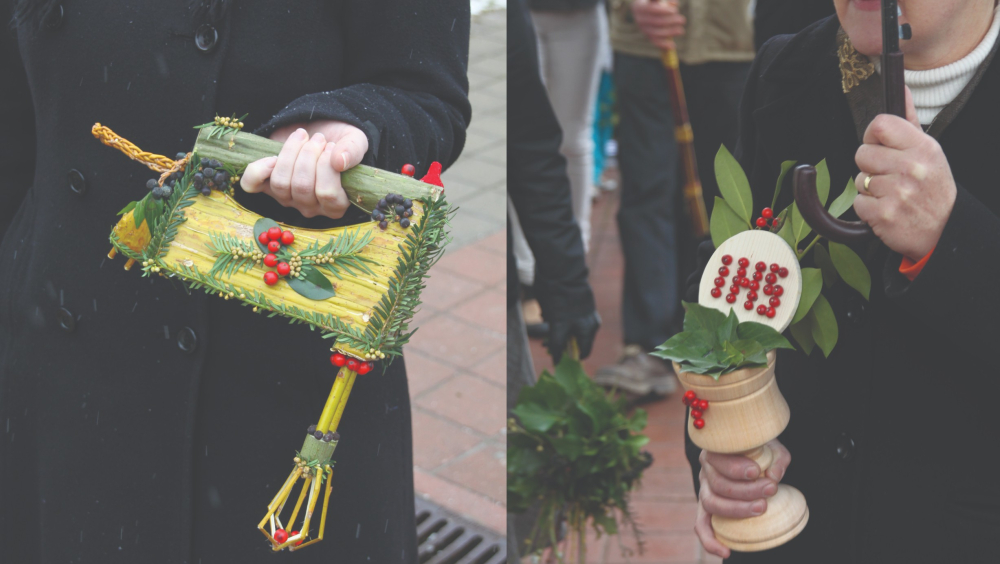PALM SUNDAY BUNDLES OF WOOD (“CVETNONEDELJSKE POTICE”)
The distinctive special feature of Ljubno are the traditional Palm Sunday bundles, locally called the “Ljubenske potice” (“the Ljubno bundles of wood”). Tradition goes hand in hand with the local way of life; it’s an acknowledgement of folk art, with interweaving aesthetics and functionality that manifests a typical motif of the bundles, which, much like the tools used for their preparation, changes over time. A typical image of the Ljubno bundles present the tools, objects and the scenery from everyday farm life, as well as sacred objects and religious symbols. Modern-day motifs, such as electronic devices, motifs of animals and other objects (skis, fishing rods, binoculars, tennis rackets...) are also starting to emerge today. The bundles are meant to be handmade using natural material available according to the season and found in the vicinity of home: fresh greenery, wicker, tree bark, fruit... They must consist of seven types of wood: holly, goat willow, yew, ivy, basket willow, boxwood and Cornelian cherry. Despite of the rule stating that bundles should be handmade, the modern technology these days is becoming indispensable in the increasingly complex and precise production of bundles. The term bundle (“potica” in English “a cake”) most likely derives from the past use of a combination of bread, or pastries with young spring greens on Palm Sunday bundles. At the end of the 19th century, it was customary for men to compete on Palm Sunday, to see who would manage to bring the biggest bundle to the blessing. Jože Poličnik, a weak and feeble boy, was said to have made the first figural bundle. Since he could not compete with his stronger peers in terms of strength, he decided to make the most beautiful bundle in the shape of a carpenter’s sack. The locals were fond of the idea and ever since, the intriguing figural bundles are each year brought to be blessed on Holy Sunday.
The year was 1887. Palm Sunday was approaching. Jože Poličnik, a little boy with a lanky build, was in a dilemma. While he was capable of creating the biggest and the heaviest bundle, he would never be able to carry it. It was then that he decided to do something completely out of the ordinary. Even if it won’t be the biggest, it will be the prettiest, he thought to himself and got to work. He brought a toolbox to the church, which he made from different types of wood and fresh greenery. When he proudly brought his creation to the blessing, the priest laughed and mocked him: “Look at Jože, he made a carnival figure.” He didn’t let the remarks and the mocking get to him. On the contrary, he decided to next year create something people would remember forever. He created a cow. When the church caretakers found out what he was planning to bring to the church, they decided to try and stop him from doing so. But here comes the twist. The cow was built in such an incredible way, it made them change their mind. It wasn’t long before guys in Ljubno were no longer competing to see who could make and bring the biggest the heaviest bundle to the blessing but instead started competing in creativity. Thus, in 1925, the Murčevo boys carved a life-size plough out of a tree trunk. They also brought a spinning wheel covered in ivy to the blessing and spun it at the “Plac” (the main square) in front of the church. The creativity of boys from Ljubno contributed to the emergence of the Ljubno bundles. Bundles like those created in Ljubno ob Savinji can’t be found elsewhere in Slovenia, nor in the rest of Europe. The name bundle originates from the local dialect. If you order potica (cake) at one of the inns in Ljubno, you’re in for a surprise. You will be served a plate with apple strudel. The potica here is called a ring cake (“šarkelj”). And because their bundles are wrapped, stuffed with greenery, sometimes even apples, they named them poticas (cakes). However, anyone who decides to make them must follow a set of rules. The bundles must be made with seven types of wood: holly, goat willow, yew, ivy, basket willow, boxwood and Cornelian cherry. The wood must be collected near a creator’s home and the same applies to fresh greens, bark, twigs and fruits. If a type of wood is not available, it can be left out or replaced with another type of wood, with the exception of common willow wood, which must never be used. Even though willow branches would be ideal for crafting due to their softness and pliability, they are not allowed to be used, as the apostle Judas Iscariot hanged himself on a willow tree. While the rules stipulate that the bundles must be handmade, many creators these days are already using modern technology to help them. Three basic motifs. The most original creators usually begin thinking about bundle motifs more than a month before Palm Sunday. A real competition in originality takes place with everyone trying to come up with something unique and special. Most often, they depict objects from everyday life, such as farm tools, devices for working the soil and processing wood. Other types of motifs relate to the interior decor of residences, which also includes books and musical instruments. The third group consist of sacral objects, religious symbols, as well as rafts, bridges, mills, sawmills, granaries, haystacks, beehives... In recent years, manufacturers also like to depict human and animal figures and motifs of electronic devices. Among the newer trends, even skis, fishing rods, tennis rackets, air planes can be found ... An almost forgotten … In 1970, only six bundle makers were still recorded in Ljubno. But then Dean Martin Pušenjak arrived to the village church of St Elizabeth. The new priest was so impressed with the bundles that he began to encourage people to start making them in large numbers. The following year, he blessed 30 of them. The number of Palm Sunday bundles every year remains unknown. Some years, the priest blesses over a hundred and more different ones. Over the years, the tradition of making bundles has changed. Today, they are also being made by women, whereas in the past women used to be entrusted only with creating details and decorating with colourful ribbons. Jože Hudej has the longest experience in making bundles. He’s around 80 years old and a proud relative of Jože Poličnik, the tiny boy who made the first bundle. Hudej made his first one when he was still a child. Now his grandson, Lukas, continues the family tradition. Last year, the municipality was gifted a private collection of the late Alojz Atelšek. Alongside Hudej, he was one of the two bearers of the material heritage of the Ljubno bundles. There are approximately 70 bundles, all Atelšek’s creations in the exhibition collection that is on display in the attic rooms of the renovated Zadružni dom. They are authentic artistic sculptures, which the creator, who also professionally worked with wood, meticulously created through many decades. In 2010, at the initiative of the ethnologist Dr Janez Bogataj, Ljubno bundles were depicted on Slovenian postage stamps. Mrs. Karolina Kalan, the author of the book Ljubenske potice (“the Ljubno bundles”, 2014)), wrote as follows: After almost a century old tradition, creating something new has become a big challenge for these creators. It’s about preserving the heritage that their ancestors first brought from the hill farms to this particular church of the St. Elizabeth. And these creators modestly, humbly and often hidden from everyone’s eyes, create bundles. During the year, they are gradually burned as a blessed fire and symbolically returned to the place where they were given the power and ability to be created, to the sky, from God.
Our story goes hand in hand with this year's topic “Living heritage” because it refers to the practices, knowledge and skills that have been passed from one generation to the next, and are still in use today.



